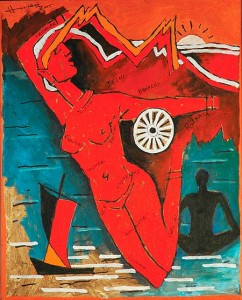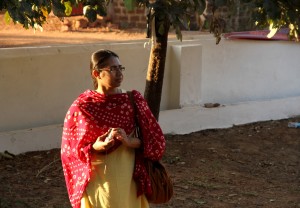 The perfect Indian woman is all about choices and she knows how to make the right one. She’s educated, knows her rights, is empowered enough to speak her mind. She’s a smart consumer who knows what suits her and will never settle for the second best. She’s net savvy, blogs her thoughts, an armchair activist saving the last of the tigers and who, when push comes to shove, will pick up a banner, clench her fist and go to a rally; a global citizen participating in the cultural milieu of the times. But she’s no feminist and she will tell you that. She may or may not be politically inclined but she makes it a point to never miss an election. Every vote counts, she’ll tell you. And I haven’t got to the best part yet- rest assured, she will make a wonderful wife and companion. Globalization may tear the earth flat, boundaries may dissolve, pillars of society may tremble and fall but the perfect Indian woman will remain perfectly Indian. Just like when your great grandfather first laid eyes on great grandma. Some things must never change and they must not so that we can believe in them. Everyone needs something to rely on, especially these days. In a world spiraling out of control right before our eyes, we all need a soft spot to rest our heads. Friend, companion, sister, wife, mother India.
The perfect Indian woman is all about choices and she knows how to make the right one. She’s educated, knows her rights, is empowered enough to speak her mind. She’s a smart consumer who knows what suits her and will never settle for the second best. She’s net savvy, blogs her thoughts, an armchair activist saving the last of the tigers and who, when push comes to shove, will pick up a banner, clench her fist and go to a rally; a global citizen participating in the cultural milieu of the times. But she’s no feminist and she will tell you that. She may or may not be politically inclined but she makes it a point to never miss an election. Every vote counts, she’ll tell you. And I haven’t got to the best part yet- rest assured, she will make a wonderful wife and companion. Globalization may tear the earth flat, boundaries may dissolve, pillars of society may tremble and fall but the perfect Indian woman will remain perfectly Indian. Just like when your great grandfather first laid eyes on great grandma. Some things must never change and they must not so that we can believe in them. Everyone needs something to rely on, especially these days. In a world spiraling out of control right before our eyes, we all need a soft spot to rest our heads. Friend, companion, sister, wife, mother India.
The perfect Indian woman is a well groomed, fair skinned, gloriously decked out TV actress playing a Goddess in a mythological serial we all watch in our minds. She has TV static running through her veins.
“The male narrative is all pervasive, be it in a news reports or an advertisement. Just look at the last few months' scam reports. We know every detail of the personal lives of Kanimozhi and Nira Radia, down to marital status, children and what kind of clothes they prefer. We never heard any of these details about the other accused men. This attitude creates an even bigger problem when the report characterises a victim of crime. A recent report on a rape incident in Mumbai details out the girls activities, her love interest and why she was there. Where’s the respite?” asks Padmalatha Ravi, editor of the online women’s magazine justfemme.in.
Her exasperation is one shared by media professionals everywhere. A recent study on gender equality on the Status of Women in News Media by the International Women’s Media Foundation conducted globally found that globally, only 27% of top managerial positions in media firms are held by women. In the Asia-Oceanic region, the figure plummets to a paltry 13%. Even at the level of reportage, women make up only 36% of the ranks.
A 2004 study on the state of women working in print media in India reveals many women who feel discriminated against at workplaces and who feel their voices, opinion and identities are subsumed by the system and the structure. To the average viewer, these facts may seem disingenuous given that the moment you turn on a news program you will inevitably find a well tailored, articulate and quite fetching female news reader reading you the daily bulletins off the prompter. But the real news, as they say, is in between the lines.
As Priti Misra, one of the journalists surveyed in the 2004 study says, "Though women are well represented in the media their voices are largely unheard. They are supposed to report on the predicaments of society at large but when it comes to themselves, they are seldom heard."
In the midst of so much media schizophrenia, caught between the dominant male narrative, attempts at objectivity and the imperative to pulp every story down to the lowest common denominator, when it comes to reporting news on and for women, it is the news on the most marginal of women that receives almost no mention in the mainstream. The dalit women, tribal women, those barely existing across the poverty line, the migrants- they find little or no representation and are largely left out of the framework of the ‘national’ media.
In today’s very special video by Varsha (click here to watch), the IndiaUnheard Community Correspondent in Bihar we get a glimpse of the ground reality of the so-called media revolution in the country’s heartlands seen through the point-of-view of two senior women journalists, Meera and Niveditha Jha. Working within the media in Patna for years, these women have seen and experienced what it means to be a woman in the rapidly changing Indian media landscape. To their disappointment, even with minor improvements, things are more or less unchanged. They are brave women who are involved in a continuing struggle against the tides. Like the stories they try to represent, they themselves are marginalized even unpopular voices against the mainstream. ‘The role of women in society is reflected in the media,’ say the women. But this has never stopped them from getting their point across and in the story by our intrepid correspondent they have found a medium for their words. They concede that change is definitely possible by sustained activism at an individual, grassroots and policy level. Women themselves, Meera and Niveditha imply, are the agents to bring about a change in the mindset of the Indian media and the nation.
Until then, we’ll be the nation that comes together in a collective carnival on the occasion of an actress’s pregnancy and wonder aloud if the rape victim was dressed appropriately. Mother India bless us all.
About Varsha:
[caption id="attachment_2152" align="alignleft" width="270"] Varsha[/caption]
Varsha[/caption]
Rather than remaining a victim, Varsha Jawalgekar deflected the blows of domestic violence inflicted upon her by her husband and became a champion of women’s rights. Currently a leader at the Parivartan Kendra (Centre for Change), Varsha also channels her human rights activism into various organizations in Maharashta and Bihar. She uses her IndiaUnheard Community Correspondent videos as calls to action for the people of her community and officials who have the power to effect positive change.
Read more about the video and an interview with Varsha here
Watch more videos by Varsha here
Read the 2004 Report on status of women in Indian news media here
Read about the global report here
picture: MF Hussain's Mother India from artindianow.in
Yashodhara – A salve for the social injuries of the Dalits in Mumbai’s slums.
Yashodhara Salve’s style of community journalism has led to Dalit women marshalling against atrocities they faced, women standing up against traditions that exile them from society and women going on camera to demand education for their daughters which is a basic right. The 38-year old Community Correspondent grew up in...
Fixing India| Catching A Human Trafficker| Featuring Navita Devi|
Because of Navita's determination and bravery, a human trafficking agent is being the bars, and the girls have returned to their homes.This is how our CC’s are helping raise issues and finding solutions.
